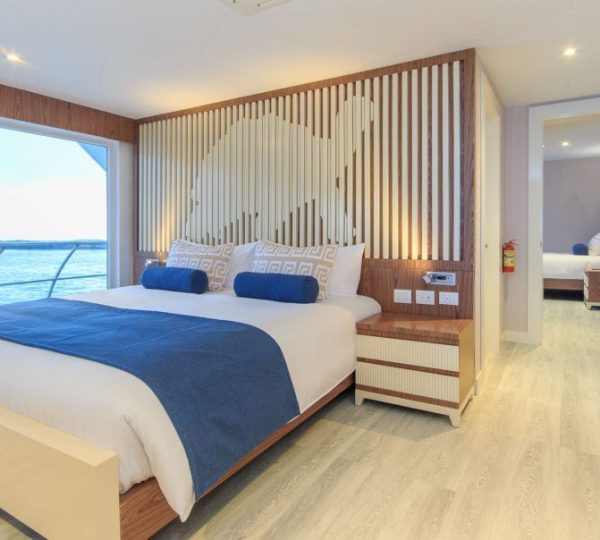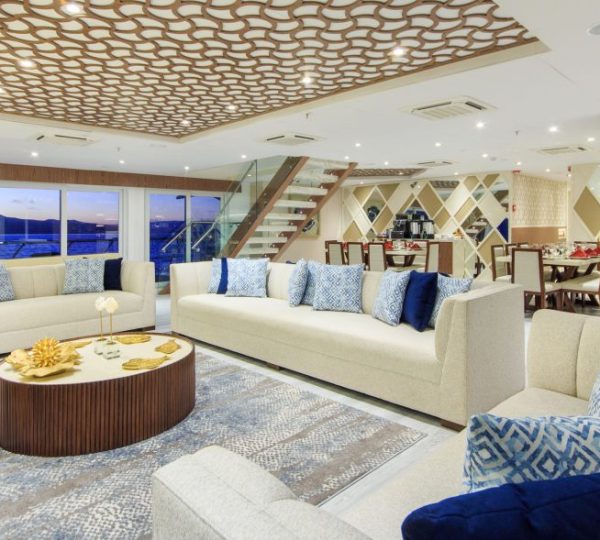Day 1: SATURDAY
Arrive at San Cristobal airport.
Saturday PM:
David Rodriguez Breeding Center
A visit to the David Rodriguez Breeding Center provides information about the origin and evolution of the giant tortoise and explains why the center is so vital in safeguarding the future of these incredible creatures.
Walking through the trails of the reserve, you can see baby tortoises being reared in semi-natural conditions – a brilliant demonstration of the commitment the local people have to preserving the wildlife that makes the Galapagos so special.
Day 2: SUNDAY
ESPAÑOLA ISLAND: Suarez Point – Gardner Bay, Gardner and Osborn Islets
Suarez Point is packed with wildlife and is best explored by following the circular walking trail. This memorable walk will take you past nesting sites of large colonies of nazca and blue-footed boobies and mockingbirds.
Also, unique to Española island are red and green marine iguanas and the beautiful waved albatrosses, that can be seen majestically launching themselves out across the ocean from the cliffs.
A geological highlight are several blow holes, capable of shooting water 25m into the air, that make for a spectacular photo.
Gardner Bay, Gardner and Osborn Islets
The pristine white sandy beach of Gardner Bay dotted with sea lions provides a perfect spot to relax, and kayaking or paddle boarding is a fantastic way to observe the large number of waved albatrosses who use this beach as a breeding site.
A short panga ride will take you to the Gardner and Osborn Islets, that are superb locations for snorkeling with young sea lions and a variety of colourful tropical fish and corals.
Day 3: MONDAY
FLOREANA ISLAND: Cormorant Point / Champion islet
Cormorant Point features two contrasting beaches: one with green-tinted sand due to the high content of olivine crystals, and another with pure white sand (commonly known as ‘Flour Beach’) derived from pulverized coral.
The saltwater lagoon is a must-see as it is frequented by one of the largest population of Galapagos flamingos as well as other shorebirds such as stilts, white-cheeked pintails and large-billed flycatchers.
A panga ride to Champion Islet, an extinct shield volcano, provides a fantastic opportunity for snorkeling in an area that is known for having a high diversity of fish.
Post Office Bay / The Baroness’ Lookout
Post Office Bay is a man-made site that offers an insight into a remarkable mailing tradition developed by British whalers in the 18th century, that visitors can still take part in today.
The beach here provides for good snorkeling and kayaking and it is also possible to descend into and walk through a lava tube. Next, take a panga ride to the Baroness’ Lookout, a volcanic rock formation named after an Australian baroness, who visited the island in the 1930’s and is believed to have mysteriously disappeared.
A short trail leads to a brilliant vantage point with panoramic views of the surrounding mangroves and coastline.
Day 4: TUESDAY
SANTA CRUZ ISLAND: Mosquera Islet
Mosquera islet is a small, flat, sandy islet located between Baltra and North Seymour islands. With no fixed trail, you are free to explore the beautiful surroundings on foot, where you will encounter a large population of sea lions, shorebirds and the striking Sally Lightfoot crabs that cling to the dark rocks.
The numerous coral reefs also make it a fantastic site for snorkeling and catching sight of a range of marine life including sharks, turtles and rays.
Charles Darwin Research Station
The Charles Darwin Research Station provides an unmissable opportunity to find out about the vital work that is being carried out to preserve the archipelago’s ecosystems.
One element of this is a significant breeding programme for Galapagos tortoises, whose numbers have been in decline since the 1970’s.
These captivating enormous reptiles are very accustomed to humans, so be sure to bring your camera for some close-ups.
Day 5: WEDNESDAY
GENOVESA ISLAND: Prince Philip’s Steps / El Barranco
El Barranco, also known as Prince Philip’s Steps, is a rocky stairway that leads past a colony of nazca and red-footed boobies and up to a plateau of dried lava.
Continuing through the thin Palo Santo forest and looking out over the plain, visitors are often treated to sites of storm petrels launching out over the ocean. A panga ride or kayaking/paddle boarding along the edge of the cliffs provides a good chance to see the elusive Galapagos fur seals nestled on the rocks, and snorkeling is a great activity if you fancy a dip with a variety of shark species.
Darwin Bay
Darwin Bay has a small sand and coral beach that provides the perfect spot for snorkeling, kayaking or paddle boarding in calm, sheltered waters in the company of hammerhead sharks, rays and a plethora of colourful reef fish. Onshore, a short trail leads along a tidal lagoon and mangroves, home to a variety of land bird species, including Nazca and red-footed boobies and swallow-tailed gulls.
The trail culminates at a viewpoint that offers a stunning view overlooking the cliffs and the bay below.
Day 6: THURSDAY
SANTIAGO ISLAND: Espumilla Beach / Buccaneer Cove
Espumilla beach, located on the northern coast of Santiago island, is an exquisite white sand beach, whose name refers to the meringue-like trails of foam left by the lapping of the waves.
Sally Lightfoot crabs are in abundance here and as a result, it is common to see predatory birds such as hawks, herons and pelicans. This idyllic location is perfect for snorkeling or kayaking/paddle boarding amongst a raft of marine life, including species of octopus, eels and sharks.
Buccaneer Cove has an interesting history as it is where sailors, buccaneers and whalers frequently anchored their vessels in search of food and water. In more recent times, it has become an important nesting site for turtles and is also popular with sea lions.
A panga ride along the eroded shoreline yields views of intriguing rock formations that provide excellent ledges for boobies, pelicans and gulls.
Egas Port
Egas Port was once the site of a salt mine, but now this impressive black sand beach is an excellent location for snorkeling and observing shorebirds, Sally Lightfoot crabs and marine iguanas.
A stroll along the wide trails inland leads you past tidal pools and rocky volcanic formations known as grottoes where it is possible to spot fur seals enjoying a spot of shade.
Day 7: FRIDAY
SANTA CRUZ ISLAND: Bachas Beach
Bachas Beach is a glorious white sand beach on which the remnants of a rusted barge, thought to have been abandoned by the Americans during WWI, can be seen.
It is a popular nesting site for turtles, so if you go for a snorkel, you might find yourself sharing the water with these wonderful creatures.
The site is also full of vibrant Sally Lightfoot and hermit crabs and elegant pink flamingos that frequent the salt water lagoon behind.
Twin craters and the Highlands of Santa Cruz
The best way to appreciate these remarkable, almost identical crater-like holes, caused by the collapse of empty lava chambers, is to take the trail that leads up and around the rims.
From this vantage point, one can revel in the beauty of the surrounding highlands, lush with ferns and an abundance of Scalesia trees.
Here, bird enthusiasts can also enjoy spotting the distinct red feathers of Vermilion Flycatchers, Darwin’s finches, Galapagos doves and, with a bit of luck, an endemic short-ear owl.
Day 8: SATURDAY
Lobos Island / San Cristobal
Accessed by panga, Lobos island gets its name from the herds of sea lions that have made their home here.
Snorkeling in the calm clear water provides a unique opportunity to see these inquisitive and playful animals up close and it is also common to be accompanied by green turtles and rays as well.
Inland there is a trail where you can expect to encounter nesting sites for blue-footed boobies and frigates.
Depart from San Cristobal Airport.






























